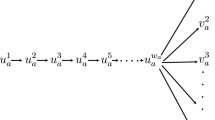Abstract
This paper investigates the classical preemptive parallel-machine scheduling problem of maximizing number of on-time jobs. While the problem is known to be NP-hard, no theoretical analysis of approximation algorithms exists in the literature. As part of the analysis, a new non-standard mixed integer formulation is developed. We propose heuristics based on different design strategies. These heuristics have asymptotically tight relative errors of 1/2. Experimental tests evaluate the computational performance of the procedures.


Similar content being viewed by others
References
Amazon.com (2017). Amazon Web Services. Accessed January 16, 2017 from https://aws.amazon.com/?nc1=h_ls.
Błażewicz, J., Ecker, K. H., Pesch, E., Schmidt, G., & Wȩglarz, J. (2007). Handbook on scheduling: From theory to applications. Berlin: Springer.
Chen, B., Potts, C. N., & Woeginger, G. J. (1998). A review of machine scheduling: Complexity, algorithms and approximability. In Handbook of combinatorial optimization (pp. 1493–1641). New York: Springer.
Cheng, T. C. E., & Sin, C. C. (1990). A state-of-the-art review of parallel-machine scheduling research. European Journal of Operational Research, 47(3), 271–292.
Galvin, P. B., Gagne, G., & Silberschatz, A. (2013). Operating system concepts. New York: Wiley.
Graham, R. L., Lawler, E. L., Lenstra, J. K., & Rinnoy Kan, A. H. G. (1979). Optimization and approximation in deterministic sequencing and scheduling: A survey. Annals of Discrete Mathematics, 5, 287–326.
Garey, M. R., & Johnson, D. S. (1978). “Strong” NP-completeness results: motivation, examples, and implications. Journal of the Association of Computing Machinery, 25(3), 499–508.
Ibarra, O. H., & Kim, C. E. (1978). Approximation algorithms for certain scheduling problems. Mathematics of Operations Research, 3(3), 197–204.
Lawler, E. L. (1979). Preemptive scheduling of uniform parallel machines to minimize the weighted number of late jobs. Report BW 105, Centre for Mathematics and Computer Science, Amsterdam.
Lawler, E. L. (1983). Recent results in the theory of machine scheduling. In A. Bachem, M. Groetschel, & B. Korte (Eds.), Mathematical programming: The State of the Art (Bonn, 1982) (pp. 202–234). Berlin: Springer.
Lawler, E. L., & Martel, C. U. (1989). Preemptive scheduling of two uniform machines to minimize the number of late jobs. Operations Research, 37(2), 314–318.
Lee, K., Leung, J. Y. T., Jia, Z. H., Li, W., Pinedo, M. L., & Lin, B. M. T. (2014). Fast approximation algorithms for bi-criteria scheduling with machine assignment costs. European Journal of Operational Research, 238(1), 54–64.
Leung, J. Y. (Ed.). (2004). Handbook of scheduling: Algorithms, models, and performance analysis. Boca Raton, FL: CRC Press.
McNaughton, R. (1959). Scheduling with deadlines and loss functions. Management Science, 6(1), 1–12.
Mokotoff, E. (2001). Parallel machine scheduling problems: A survey. Asia-Pacific Journal of Operational Research, 18, 193–242.
Moore, J. M. (1968). An \(n\) job, one machine sequencing algorithm for minimizing the number of late jobs. Management Science, 15(1), 102–109.
Pinedo, M. L. (2015). Scheduling: Theory, algorithms, and systems. New York: Springer.
Prot, D., Bellenguez-Morineau, O., & Lahlou, C. (2013). New complexity results for parallel identical machine scheduling problems with preemption, release dates and regular criteria. European Journal of Operational Research, 231(3), 282–287.
Sahni, S., & Cho, Y. (1980). Scheduling independent tasks with due time on a uniform processor system. Journal of the Association for Computing Machinery, 27(3), 550–563.
Singh, S., & Chana, J. (2016). A survey on resource scheduling in cloud computing: Issues and challenges. Journal of Grid Computing, 14(2), 217–264.
Sturm, L. B. J. M. (1970). A simple optimality proof of Moore’s sequencing algorithm. Management Science, 17(1), 116–118.
Tanenbaum, A. S., & Bos, H. (2014). Modern Operating Systems. New Jersey: Prentice Hall Press.
Tucker, A., & Gupta, A. (1989). Process control and scheduling issues for multiprogrammed shared-memory multiprocessors. ACM SIGOPS Operating Systems Review, 23(5), 159–166.
Acknowledgements
This research was supported in part by the Ministry of Science and Technology of Taiwan under the grants NSC104-2912-I-009-513 and MOST107-2912-I-009-514.
Author information
Authors and Affiliations
Corresponding author
Rights and permissions
About this article
Cite this article
Hung, HC., Lin, B.M.T., Posner, M.E. et al. Preemptive parallel-machine scheduling problem of maximizing the number of on-time jobs. J Sched 22, 413–431 (2019). https://doi.org/10.1007/s10951-018-0584-y
Published:
Issue Date:
DOI: https://doi.org/10.1007/s10951-018-0584-y




